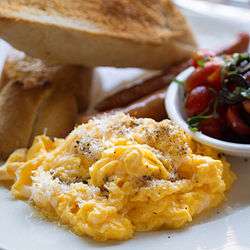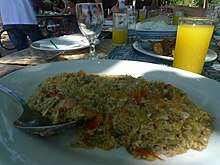Scrambled eggs
Scrambled eggs is a dish made from eggs (usually chicken eggs) stirred or beaten together in a pan while being gently heated, typically with salt, butter and sometimes other ingredients.[1][2]
 Scrambled eggs | |
| Main ingredients | Eggs |
|---|---|
| Ingredients generally used | Salt, butter |
Preparation
Only eggs are necessary to make scrambled eggs,[3] but salt is often used, and other ingredients such as water, milk, butter, chives, cream or in some cases crème fraîche, sour cream, or grated cheese may be added. Ground black pepper is sometimes used as an ingredient.[4][5] The eggs are cracked into a bowl with some salt and pepper, and the mixture is stirred or whisked: alternatively, the eggs are cracked directly into a hot pan or skillet, and the whites and yolks stirred together as they cook. More consistent and far quicker results are obtained if a small amount of thickener such as cornstarch, potato starch, or flour is added; this enables much quicker cooking with reduced risk of overcooking, even when less butter is used.[6] Adding milk or water thins out the mixture, lessens the flavor, and causes the eggs to dry out faster when put over heat because it can separate the egg.[7]

The mixture can be poured into a hot pan containing melted butter or oil, where it starts coagulating.[8] The heat is turned down and the eggs are stirred as they cook. This creates small, soft curds of egg. Unlike pancake or omelette, scrambled egg is virtually never browned. A thin pan is preferable to prevent browning. With continuous stirring, and not allowing the eggs to stick to the pan, the eggs themselves will maintain the pan temperature at about the boiling point of water, until they coagulate.
Once the liquid has mostly set, additional ingredients such as ham, herbs, cheese or cream[8] may be folded in over low heat until incorporated. The eggs are usually slightly undercooked when removed from heat, since the eggs will continue to set. If any liquid is seeping from the eggs (syneresis), this is a sign of undercooking, overcooking or adding undercooked high-moisture vegetables.
Scrambled eggs can be cooked in a microwave oven,[9] and can also be prepared using sous-vide cooking, which gives the traditional smooth creamy texture and requires only occasionally mixing during cooking.[10][11] Another technique for cooking creamy scrambled eggs is to pipe steam into eggs with butter via a steam wand (as found on an espresso machine).[12]
Variations


- American style – in American style the eggs are scooped in towards the middle of the pan as they set, giving larger curds.[3]
- English style – in English style the scrambled eggs are stirred very thoroughly during cooking to give a soft, fine texture.[3]
- In the classic French cooking method, Escoffier describes using a double boiler[13][14] as the heating source, which does not need adjustment as the direct heating method would. The eggs are directly placed in the cooker and mixed during the heating and not before. Cooking by this method prevents the eggs from browning while being cooked and gives aerated and creamy scrambled eggs.[14] This method was used in the "old classical kitchen" and guarantees the eggs are always cooked perfectly; it is, however, more time-consuming than the modern skillet method, taking up to 40 minutes to ensure perfect quality.[13]
- Buttered Eggs - a typically English dish, often mentioned in 19th and early 20th century literature;[15] additional butter is melted and stirred into the egg mixture before cooking.[16]
- Egg bhurji – Indian variant of scrambled eggs. Additions include onions, green chili, chopped ginger, turmeric powder and chopped tomatoes. Sprinkled with chopped green coriander and eaten with roti. Another variant of egg bhurji is the Parsi akuri.
- The dish is called "fried eggs" in Nigeria. The mai shai stalls cook scrambled eggs to the point of being heavily crisp.[17]
- Eggs frizzle - scrambled egg dish made with chipped beef "frizzled" in butter before eggs are added to the pan and scrambled. To make a variation called "Eggs a la Caracas" the beef is frizzled with tomatoes, spices and grated cheese.[18]
- Migas – a Tex-Mex dish (not to be confused with the Iberian dish of the same name) consisting of scrambled eggs augmented with strips of corn tortilla, to which vegetables and meat may be added.
- Onions and scrambled eggs – another variant of scrambled eggs eaten in the Philippines. The onions are either fried first then the egg mixture is poured over them to cook, or the onions are mixed with the egg mixture and then poured over the pan.
- Parrot eggs ("Perico" in Spanish) is a dish in Venezuelan cuisine and Colombian cuisine prepared with scrambled eggs, butter, sautéed diced onions, and tomatoes.[19] White cheese is also sometimes used.[20]
- Poqui poqui - a Filipino dish consisting of grilled eggplants with sauteed garlic, tomatoes, and shallots and scrambled eggs.[21][22]
- Scotch woodcock – British variant of scrambled eggs, served over toast that has been spread with Gentleman's Relish.[23]
- Scrambled eggs à l'arlésienne – with zucchini (courgette) pulp and a concentrated garlic-flavored tomato fondue served in hollowed-out courgettes and sprinkled with Parmesan cheese.
- Scrambled eggs à l'américaine – with pan-fried smoked bacon, garnished with slices of broiled bacon and small grilled tomato halves.[24]
- Scrambled eggs with digüeñes – a variation from Chilean cuisine in which the eggs are fried together with the native fungus Cyttaria espinosae, or sometimes spinach.
- Scrambled eggs with sucuk or pastırma; sucuklu yumurta and pastırmalı yumurta respectively – scrambled eggs are mixed with Turkish beef sausages, or dried cured beef. It is cooked in a sahan (a shallow dish) with butter or olive oil. Some tomato can be added. In Turkey and Egypt it is eaten regularly for breakfast.
- Soy scrambled eggs – mixed with soy sauce and often eaten with congee.
- Stir-fried tomato and scrambled eggs – a very common main course in China. It is inexpensive and quickly and easily prepared, and so is a favourite among teens and university students. This is also eaten in the Philippines.
Serving styles
.jpg)
Classical haute cuisine preparation calls for serving scrambled eggs in a deep silver dish. They can also be presented in small croustades made from hollowed-out brioche or tartlets.[13] When eaten for breakfast, scrambled eggs often accompany toast, bacon, smoked salmon, hash browns, maize, pancakes, ham or sausages. Popular condiments served with scrambled eggs include ketchup, hot sauce, and Worcestershire sauce.
See also
- Fried egg
- Ham and eggs
- List of brunch foods
- List of egg dishes
- Poached egg

Notes
- Liesa Cole, L.J.L. Quick and Easy Cooking: Meals in Minutes. Globe Pequot. p. 50. ISBN 978-1-59921-754-3. Retrieved August 21, 2017.
- David, E.; Child, J.; Renny, J. (1999). French Provincial Cooking. Penguin twentieth-century classics. Penguin Publishing Group. pp. 222–223. ISBN 978-1-101-50123-8. Retrieved August 21, 2017.
- "How To Make Perfect Scrambled Eggs - 3 ways". Jamie Oliver. YouTube. Retrieved August 21, 2017.
- Berolzheimer, R. (1988). Culinary Arts Institute Encyclopedic Cookbook. Perigee Series. Perigee Books. p. 287. ISBN 978-0-399-51388-6. Retrieved August 21, 2017.
- Simon, Alexander (August 7, 2017). "How to make scrambled eggs in a microwave, without dirtying a pan". Standard Republic. Retrieved August 21, 2017.
- Miglore, Kristen (May 29, 2015). "Cornstarch in scrambled eggs makes them magically creamy in 15 seconds". Slate Magazine. Retrieved August 21, 2017.
- Exchange, The Culinary (2016-08-02). "Kitchen Questions: Should You Put Milk in Scrambled Eggs?". The Culinary Exchange. Retrieved 2019-08-15.
- Smith, Delia (2005). "Scrambling eggs". Complete cookery course. London: BBC Books. p. 23. ISBN 0-563-36249-9.
- Dobrowolski, J. (1996). Cheap and Easy Cooking: The Survival Guide for College Students. S.K.I. Publishing Company. p. 17. ISBN 978-0-9654612-0-7. Retrieved August 21, 2017.
- Heston Blumenthal at home: Scrambled eggs with brown butter
- Wylie, C. (2017). The Sous Vide Kitchen: Techniques, Ideas, and More Than 100 Recipes to Cook at Home. Voyageur Press. p. 215. ISBN 978-0-7603-5203-8. Retrieved August 21, 2017.
- "Chef Jody Williams Shows Me How to Steam Scramble Eggs". FoodMayhem. April 17, 2012. Retrieved August 21, 2017.
- Escoffier, 157
- McClusky, P. (2015). Ontario Garlic: The Story from Farm to Festival. Arcadia Publishing Incorporated. p. 27. ISBN 978-1-62585-451-3. Retrieved August 21, 2017.
- Yates, Dornford (1932). Safe Custody (Faded Page Canada 2016 ed.). London: Ward Lock & Co. Limited. p. 156.
- "Buttered Eggs". The Foods of England Project. Retrieved 30 April 2019.
Eaton 1822, Mrs. B. &c
- Kperogi, Farooq (January 26, 2014). "Q and A on the grammar of food, usage and Nigerian English". Daily Trust. Retrieved February 23, 2017.
- Eades, Michael R. Protein Powder. Random House. Retrieved 17 August 2019.
- de Silva, J. Venezuelan Cookbook - Classic Venezuelan Recipes:. Springwood emedia. p. 6. ISBN 978-1-301-28379-8. Retrieved August 21, 2017.
- Kraig, B.; Sen, C.T. (2013). Street Food Around the World: An Encyclopedia of Food and Culture. ABC-CLIO. p. 391. ISBN 978-1-59884-955-4. Retrieved August 21, 2017.
- Manalo, Lalaine. "Poqui Poqui". Kawaling Pinoy. Retrieved 18 December 2019.
- "Poqui Poqui". Ang Sarap. Retrieved 18 December 2019.
- Vaughan, B. (2015). Egg: The Very Best Recipes Inspired by the Simple Egg. Orion Publishing Group. p. 37. ISBN 978-0-297-87161-3. Retrieved August 21, 2017.
- Robuchon, 17
References
- Escoffier, Georges Auguste. Escoffier: The Complete Guide to the Art of Modern Cookery. Translated by H. L. Cracknell and R.J. Kaufmann. New York: John Wiley and Sons, 2002
- FoodMayhem.com. Chef Jody Williams Shows Me How to Steam Scramble Eggs. New York: FoodMayhem.com, 2009.
- McGee, Harold. On Food and Cooking: The Science and Lore of the Kitchen. New York: Scribner, 2004.
- Robuchon, Joël, Members of the Gastronomic Committee. Larousse Gastronomique. New York: Clarkson Potter/Publishers, 2001.
External links

